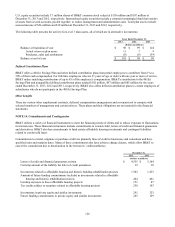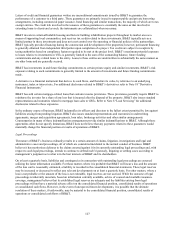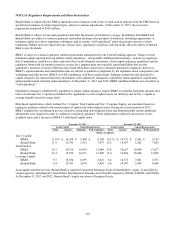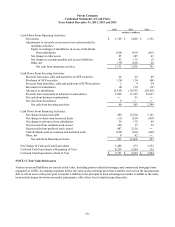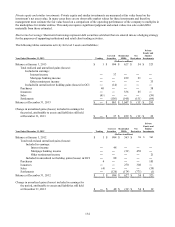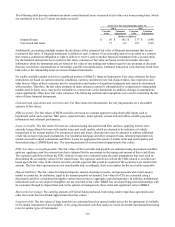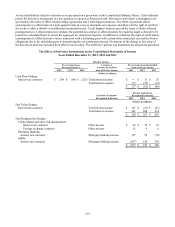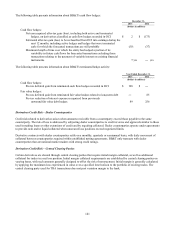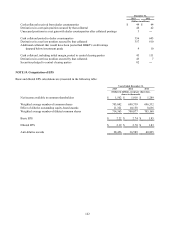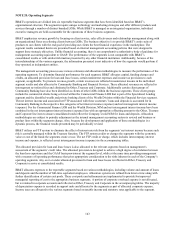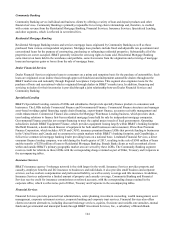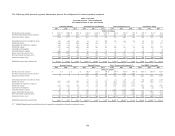BB&T 2013 Annual Report Download - page 136
Download and view the complete annual report
Please find page 136 of the 2013 BB&T annual report below. You can navigate through the pages in the report by either clicking on the pages listed below, or by using the keyword search tool below to find specific information within the annual report.
136
The following table provides information about certain financial assets measured at fair value on a nonrecurring basis, which
are considered to be Level 3 assets (excludes covered):
As Of / For The Year Ended December 31,
2013 2012
Carrying
Value
Valuation
Adjustments
Carrying
Value
Valuation
Adjustments
(Dollars in millions)
Impaired loans $ 50 $ (41) $ 137 $ (109)
Foreclosed real estate 71 (6) 107 (147)
Additionally, accounting standards require the disclosure of the estimated fair value of financial instruments that are not
recorded at fair value. A financial instrument is defined as cash, evidence of an ownership interest in an entity or a contract
that creates a contractual obligation or right to deliver or receive cash or another financial instrument from a second entity.
For the financial instruments not recorded at fair value, estimates of fair value are based on relevant market data and
information about the instrument and are based on the value of one trading unit without regard to any premium or discount
that may result from concentrations of ownership, possible tax ramifications, estimated transaction costs that may result from
bulk sales or the relationship between various financial instruments.
No readily available market exists for a significant portion of BB&T’s financial instruments. Fair value estimates for these
instruments are based on current economic conditions, currency and interest rate risk characteristics, loss experience and
other factors. Many of these estimates involve uncertainties and matters of significant judgment and cannot be determined
with precision. Therefore, the fair value estimates in many instances cannot be substantiated by comparison to independent
markets and, in many cases, may not be realizable in a current sale of the instrument. In addition, changes in assumptions
could significantly affect these fair value estimates. The following methods and assumptions were used in estimating the fair
value of these financial instruments.
Cash and cash equivalents and restricted cash: For these short-term instruments, the carrying amounts are a reasonable
estimate of fair values.
HTM securities: The fair values of HTM securities are based on a market approach using observable inputs such as
benchmark yields and securities, TBA prices, reported trades, issuer spreads, current bids and offers, monthly payment
information and collateral performance.
Loans receivable: The fair values for loans are estimated using discounted cash flow analyses, applying interest rates
currently being offered for loans with similar terms and credit quality, which are deemed to be indicative of orderly
transactions in the current market. For commercial loans and leases, discount rates may be adjusted to address additional
credit risk on lower risk grade instruments. For residential mortgage and other consumer loans, internal prepayment risk
models are used to adjust contractual cash flows. Loans are aggregated into pools of similar terms and credit quality and
discounted using a LIBOR based rate. The carrying amounts of accrued interest approximate fair values.
FDIC loss share receivable/payable: The fair values of the receivable and payable are estimated using discounted cash flow
analyses, applying a risk free interest rate that is adjusted for the uncertainty in the timing and amount of these cash flows.
The expected cash flows to/from the FDIC related to loans were estimated using the same assumptions that were used in
determining the accounting values for the related loans. The expected cash flows to/from the FDIC related to securities are
based upon the fair value of the related securities and the payment that would be required if the securities were sold for that
amount. The loss share agreements are not transferrable and, accordingly, there is no market for the receivable or payable.
Deposit liabilities: The fair values for demand deposits, interest-checking accounts, savings accounts and certain money
market accounts are, by definition, equal to the amount payable on demand. Fair values for CDs are estimated using a
discounted cash flow calculation that applies current interest rates to aggregate expected maturities. In addition, nonfinancial
instruments such as core deposit intangibles are not recorded at fair value. BB&T has developed long-term relationships with
its customers through its deposit base and, in the opinion of management, these items add significant value to BB&T.
Short-term borrowings: The carrying amounts of Federal funds purchased, borrowings under repurchase agreements and
other short-term borrowed funds approximate their fair values.
Long-term debt: The fair values of long-term debt are estimated based on quoted market prices for the instrument if available,
or for similar instruments if not available, or by using discounted cash flow analyses, based on current incremental borrowing
rates for similar types of instruments.


